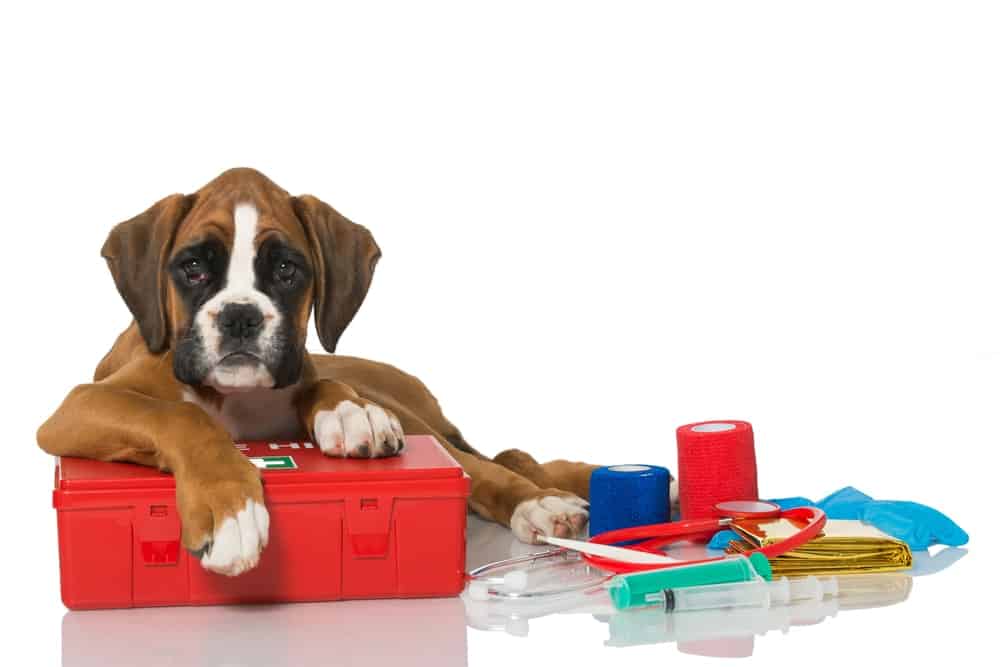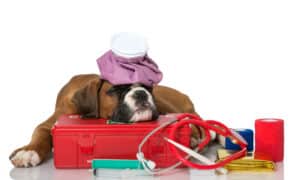“This post contains affiliate links, and I will be compensated if you make a purchase after clicking on my links.”
Chances are, you’ve got a first aid kit for the humans in your home or, at the very least, a variety of first aid supplies in your medicine cabinet in the event of an emergency. But, do you have one for your dog, too?

Of course, you can buy a pre-made kit at your local pet store or online, or in just a few minutes you can build a first aid kit for your dog at home! Be prepared for anything from scrapes and scratches, to ticks, bug bites, and broken bones until you can get your pup to the vet.
The Basics
Because each dog is different, no single ready-made first aid kit will completely meet the needs of your unique four-legged friend. But, the following items, the basics, are a must in every kit.
Start with a zippered bag or lidded container that’s large enough to hold everything in your kit, but compact and lightweight enough to be carried or taken along when you travel. Then, add the following:
- Sterile gauze – can be used for bandaging wounds, to stop bleeding, or to clean wounds.
- Cotton balls – great for cleaning and applying antiseptic to small wounds and insect bites as well as cleaning ears.
- Instant heat and/or cool packs – heat packs can be used to warm a hypothermic pet or soothe joint and muscle injuries, while a cool pack can cool skin after a burn or reduce inflammation and pain in other injuries.
- Liquid bandage
- Ear wash/cleaner
- Eye rinse
- Wound wash/antiseptic rinse or pre-moistened wipes
- Antibiotic skin cream or ointment
- Benadryl (or other dog-safe antihistamine) for quick treatment of dangerous bug bites and bee stings. TIP: Find the dye-free “liqui-gel” capsules and tape a small safety pin to the back of the silver foil pack. In an emergency, poke the capsule with the safety pin and squeeze directly into your dog’s mouth.
- Styptic powder – to stop bleeding quickly and safely.
- Tweezers – for removing splinters and stingers.
- Safety-tipped Scissors
- Fast-Read digital thermometer
- Tick removal tool or pads
- 3% Hydrogen Peroxide – to induce vomiting when necessary. Dosage is one teaspoon for every 10 pounds of your dog”™s body weight, given orally. (Reminder: Hydrogen Peroxide DOES lose its efficacy over time. Check your bottle for an expiration date and replace every few months to ensure it will work when you need it to!)
- A syringe – for administering liquid medications, providing fluids when necessary, or flushing wounds.
- Pet Bandages – require no clips or tape, but adheres to itself without sticking to or pulling on pet hair. Can also be used as a tourniquet if needed.
- Latex-free exam gloves
Items specific to YOUR pet:
- Medical records – proof of rabies and other vaccinations, a list of your dog”™s allergies.
- Medications – if your dog is currently taking medication, keep a small supply available in your first aid kit.
- Extra Collar and Leash – with identification tags.
You May Also Want to Include…
With the above items in your kit, you’re well prepared in the event of any emergency. Though the following items aren’t always a must-have, they will most certainly be useful in your kit:
- A muzzle. Any dog can bite, even the gentlest, sweetest dog you’ve ever known, especially when injured and afraid. When dealing with very serious injuries and/or with unknown dogs, it’s a good idea to muzzle the dog.
- Towels, washcloths, or a blanket – If you’ve got room in your kit, these are useful in a variety of situations.
- A list of emergency phone numbers: your regular vet, closest emergency vet, your local animal control, and pet poison hotline. It’s a good idea to have these programmed in your cell phone, too.
- If you plan to bring your kit along during travel or long hikes/walks, include materials for creating a splint in the event of serious sprain or broken bones – tongue depressors or short dowel rods and strips of fabric or surgical tape will work well.
The First Aid Kit is Just the First Step in Protecting Your Pet
Having all of these essential supplies on hand and easily accessible is an excellent start – but knowing how and when to use them is just as important!
Find a Pet First Aid book that details a variety of emergency situations and explains how to deal with them until you can get your dog to a veterinarian. And, don’t wait for an emergency to strike before reading the book. (If you’ve got the space, store the book in your first aid kit for quick reference when needed.)
Attend a Pet CPR and First Aid Class. You’ll not only learn life-saving CPR in the event that your dog stops breathing, these classes typically use fake “dummy dogs” that allow you to practice CPR and first aid techniques first hand so you’ll be prepared and experienced in handling an emergency.
Building a first aid kit for your dog at home may seem unnecessary, and hopefully you’ll never need it – but being prepared for an emergency will give you peace of mind, and could be the difference between life and death of your furry friend.
Do you have a first aid kit for your dog at home? See any necessary items not listed above that should be included? Let us know in the comments below!























